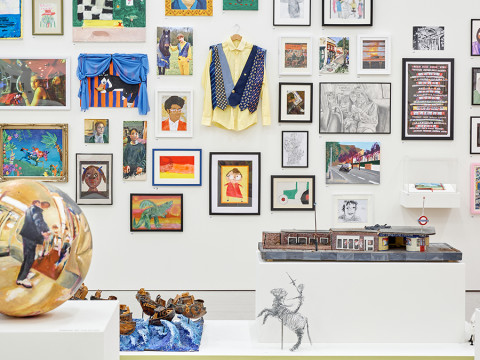
Why children’s art matters
By Neil Walton
Published on 8 July 2024
As the Young Artists’ Summer Show returns to the RA, art educator Neil Walton states that now, more than ever, young people need encouragement to value art in their lives.
From the Summer 2024 issue of RA Magazine, issued quarterly to Friends of the RA.
As an art educator who has worked extensively with children and young people, I often reflect on what a privilege it is to spend time with the amazing and unexpected things they create. Walking into the RA’s Young Artists’ Summer Show – an annual open-submission exhibition of work by pupils aged 4 to 19 – is a wonderful, joyous experience, with artworks of all types and sizes covering walls and floor. What stands out is the variety, with every piece giving insight into a child’s imagination and what they noticed or immersed themselves in, either in a flurry of making or perhaps over an extended period of time.
Of course, art can be about that intensely private absorption that you see on children’s faces while they work, but it is also about the delight of sharing something felt and made. What a great experience for those in the Young Artists’ Summer Show to have viewers of all ages admiring and discussing their work.
My job is all about learning in art. Having spent years in the classrooms of London’s schools, I now work in teacher education. On our PGCE course at Goldsmiths we are always thinking about how we can make sure we give all children a positive and inspiring experience of art from the start of their schooling.
Beyond those first encounters, we want to take them further on that journey, stretching and challenging them to go deeper into the subject, to help them to feel that art is something they own – not something for other, special or more privileged people. Art is something we all start off owning, but to keep it that way requires the caring and passionate work of education.

Heart Radio, 2024

Testudo Kleinmanni, 2024

Agoraphobic, 2024

Waves at Night, 2024
Imagine a child choosing the colour blue when painting. She is thrilled by the glossy bluey blueness of the paint as the brush hairs splay against the matt paper. That’s a highly personal experience, but at the same time she is already participating in a shared human endeavour with a great, rich and deep history. She already has an emerging sense of the norms of the practice – that it is right to put the paint marks on the paper and not on the carpet or a passing cat; that marks placed on the paper will be given a special sort of shared attention by adults and can be discussed and evaluated. Later, with the support of inspiring teachers, she may extend her understanding of blue within the knowledge domain of art, with its rules and terminology. She might learn that a commitment to painting with only one colour rules out simultaneously exploring colour mixing with pointillist spots of complementary colours. Perhaps as an older learner, she might engage with how Helen Frankenthaler’s technique of staining the canvas negated aspects of Jackson Pollock’s handling of the painted surface, or with how Natalia Goncharova’s use of blue to symbolise cleanliness in her 1913 painting Linen signalled a critique of bourgeois academicism. But all that learning starts with the first moment of wonder and personal engagement.
In recent years, the arts have had a hard time in schools, being squeezed by official performance indicators, but art and design remains an essential component of the curriculum. It’s a subject that develops a learner’s senses, intellect, physical skill and
imagination. It links practical, theoretical and art-historical knowledge, and it ranges from the simplest mark-making to learning about art’s complex histories with all its triumphs as well as its biases and exclusions.
The vibrant work on display in the Young Artists’ Summer Show demonstrates how impressively children can engage with and take ownership of a wide range of traditional, modern and contemporary forms of art.
Neil Walton is Subject Leader in PGCE Art and Design at Goldsmiths, London, and a Visiting Professor at the RA Schools.
Young Artists' Summer Show 2024 is at the Royal Academy of Arts from 16 July – 11 August 2024.

Enjoyed this article? Join the club
As well as free entry to all of our exhibitions, Friends of the RA enjoy one of Britain’s most respected art magazines, delivered directly to your door. Why not join the club?
Related articles

How does the RA judge art by children?
21 June 2023

Why we need to take child art seriously
27 June 2022



